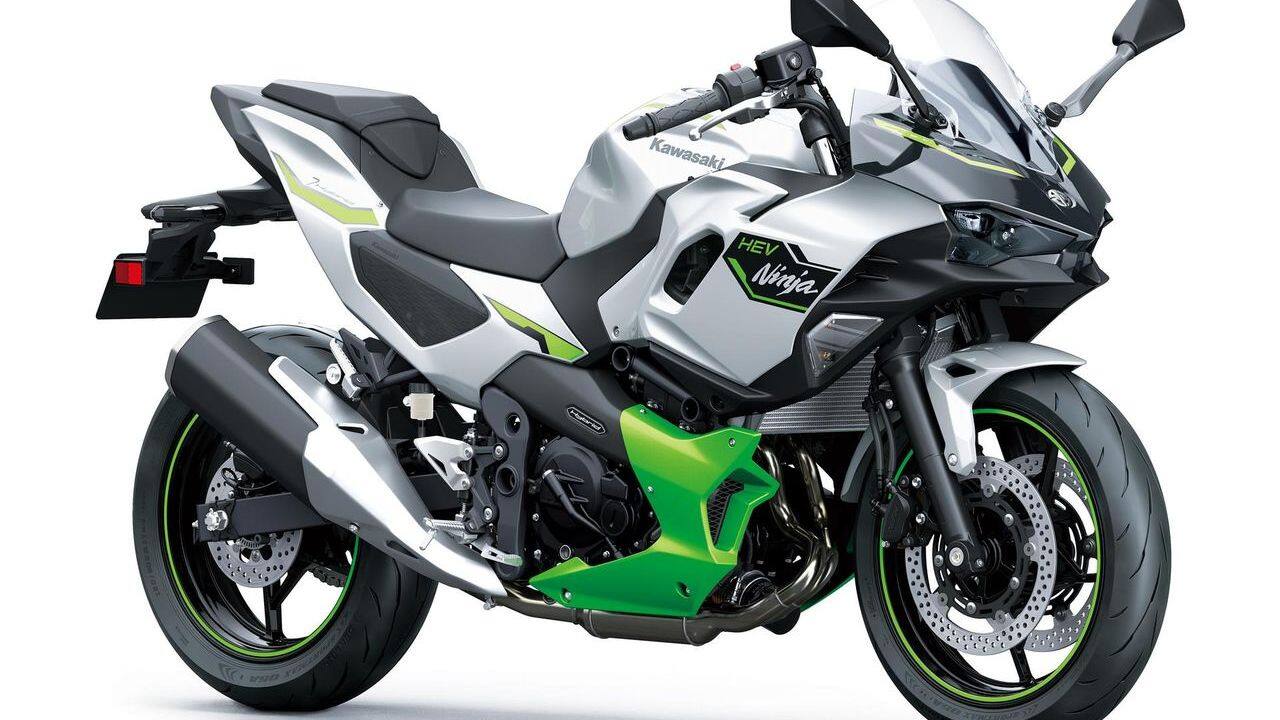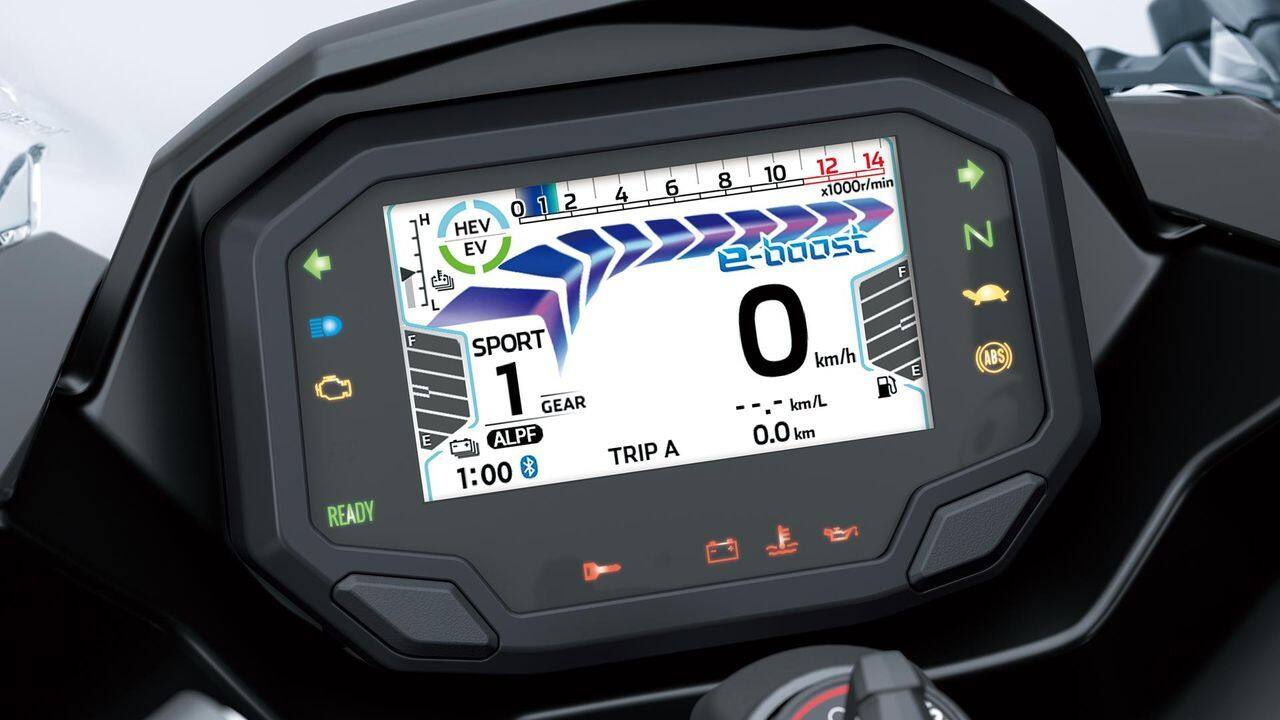Kawasaki unveils world’s first strong hybrid production motorcycle — Ninja 7 HEV
The Kawasaki Ninja 7 HEV is the world’s first mass-production strong hybrid motorcycle. According to the Japanese manufacturer, this bike is capable of delivering 650cc segment power combined with the fuel efficiency of a 250cc segment motorcycle
1/11

While hybrid cars have been seen on streets for years now, there was never truly a hybrid motorcycle for the green rider. Our favourite manufacturer, however, has decided to change this. Kawasaki just recently unveiled the Ninja 7 HEV, an ICE motorcycle mated to an electric motor. But that’s not it. There are some other features, too, that may not be the first on a motorcycle but definitely a first for Kawasaki. (Image: Kawasaki)
2/11

The design: Let’s talk about design first. Taking inspiration from the ZX-6R (which has been delayed for India, by the way) the Ninja 7 looks sharp. The dual-pod LED headlamp seems to be pulled off from the ZX-6R while the fairing-mounted turn signals come out of the Ninja 400. But the front is where most of the similarities end. The lower fairing and chunky tail section gives the Ninja 7 a very muscular stance. (Image: Kawasaki)
3/11

Then you have the distinct colour scheme for the HEV. Most of the body panels are finished in this semi-matte silver paint complete with the Ninja HEV graphics in black, white and green. The lower cowl, however, adds a lot of contrast with its punchy lime-green paint. The headlamp cowl, too, has been given a blacked-out pinstriped in green for that aggressively sporty look. (Image: Kawasaki)
4/11

Weighing in at 227 kg, however, the Ninja 7 HEV isn’t light around the block and there could be some getting used to. Fortunately, the seat height is as low as 795 mm, so managing the weight will be that much easier. (Image: Kawasaki)
5/11

The performance: Now, the Ninja 7 is what Kawasaki is calling a strong hybrid motorcycle and a look at the specs tells us that it’s not far off the mark. According to Kawasaki, the HEV boasts of performance equal to that of a 650cc-700cc segment motorcycle all the while providing the fuel efficiency of a 250cc segment bike. The bulk of the moving force comes from a 451cc liquid-cooled parallel twin engine. This is then mated to a 9 kW electric motor that draws energy from a 48-volt lithium-ion battery that’s positioned under the seat. The total power output from this setup is claimed to be 58.3 hp. (Image: Kawasaki)
6/11

Engage the e-boost function and the output jumps to 68.5 hp for 15 seconds. The combined torque figure stands at 60.4 Nm. One of the features, never seen before on a Kawasaki is the addition of automatic gears. Instead of the clutch and gear lever, Kawasaki has opted to go in for two tiny paddles on the left-hand-side switchgear in case you would like to change gears manually, similar to Honda’s DCT bikes. There is also a function called Automatic Launch Position Finder, which allows the rider to shift directly into first gear with the press of a button. (Image: Kawasaki)
7/11

Now, all of this sits inside Kawasaki’s typical steel trellis chassis suspended on 17-inch five-spoke alloy wheels. Braking duties are handled by a 300 mm dual-disc setup and dual-piston callipers up front and a single 250 mm rotor and dual-piston calliper at the rear. The suspension comes from a conventional 41 mm telescopic front fork and rear monoshock with preload-adjustability. (Image: Kawasaki)
8/11

The features: One of the other noteworthy features the bike boasts of is the idle start-stop function. By no means revolutionary, this does help in keeping fuel usage low by switching off the engine at a standstill. The Ninja 7 also comes with a walk mode. This is a low-speed forward and reverse option which helps lug that 227 kg mass of metal and plastic around in very low-speed situations such as parking. This feature first debuted on Kawasaki’s electric bikes the Ninja e-1 and the Z e-1. (Image: Kawasaki)
9/11

There are also riding modes to choose from – EV, Eco Hybrid and Strong Hybrid. Unfortunately, Kawasaki hasn’t given us range figures, so we don’t know how far you could travel in pure EV mode. Kawasaki also says that the ICE engine will automatically cut in when the charge is nearing depletion. Other features include a full-colour TFT dash, Bluetooth connectivity via a custom Rideology app from Kawasaki, dual-channel ABS as standard and all-LED lighting. (Image: Kawasaki)
10/11

An article released by Kawasaki says, “As the first of its kind, the Ninja 7 Hybrid sets the bar for HEV motorcycling. Offering the best elements of ICE and EV models, and being able to navigate both the urban jungle and countryside backroads, this revolutionary new model is greater than the sum of its parts. With its exciting character and numerous innovative features for riders to explore, the Ninja 7 Hybrid truly ushers in a new era in riding experiences.” (Image: Kawasaki)
11/11

The Kawasaki Ninja 7 HEV is slated to hit European showrooms in January, next year. Now, when or even whether the Ninja 7 makes it to India, we will have to wait and watch. However, with the launch of the ZX-4R, it does seem like Kawasaki seems to be trying out new strategies. Now we have our fingers crossed for the Ninja e-1 and Z e-1 as well but we don’t expect news any time soon. (Image: Kawasaki)
Discover the latest Business News, Budget 2025 News, Sensex, and Nifty updates. Obtain Personal Finance insights, tax queries, and expert opinions on Moneycontrol or download the Moneycontrol App to stay updated!





